Courtesy of the Green Mountain Club.
Jay Community Recreational Centre-
The Jay Land Trust Community Recreational Centre—JCRC was founded for the purpose of conserving landscape, scenic vistas and important wildlife habitats while promoting the health and well-being of the community of Jay through the protection of forest resources, recreational and educational opportunities, and other natural resources on protected property for present and future generations. Our commitment to this area has grown and we have been investing in a variety of resources to improving the trails.
JCRC is located on the Cross Road in Jay, Vermont and has ample parking at this trailhead. We currently have over 16 miles of safe, well-maintained multiple-use trails for non-motorized sports spread over 240+ acres of beautiful terrain, and offer EASY and FREE access to a system of well-marked and maintained walking—hiking—running—biking—cross country skiing—snowshoeing trails. These trails offer a myriad of family friendly trails and areas for all ages and abilities.
Beginning with our first snow, our Nordic trails are open to all―whether it be cross-country skiing, snowshoeing, hiking, walking or winter biking. We encourage local residents and visitors of all ages to “Get out and Get Physical” to improve health and fitness in our natural setting.
This past summer and fall we have completed the installation of a Gazebo for shelter, a 2-stall composting privy, one of which is ADA compliant, and a mountain biking skills progression park accessed by smooth, easy trails for beginner bikers and exercisers, encouraging and enabling all to exercise in our beautiful natural habitat.
JCRC―Making a Difference―providing snapshots of our scenic vistas and benefits they bring to our community. We welcome all to come and enjoy the panoramic landscapes our recreational area has to offer.
Hiking at the Top of VT – CLICK THE LINK TO VIEW OUR TRAIL MAP
Hiking 101 Series
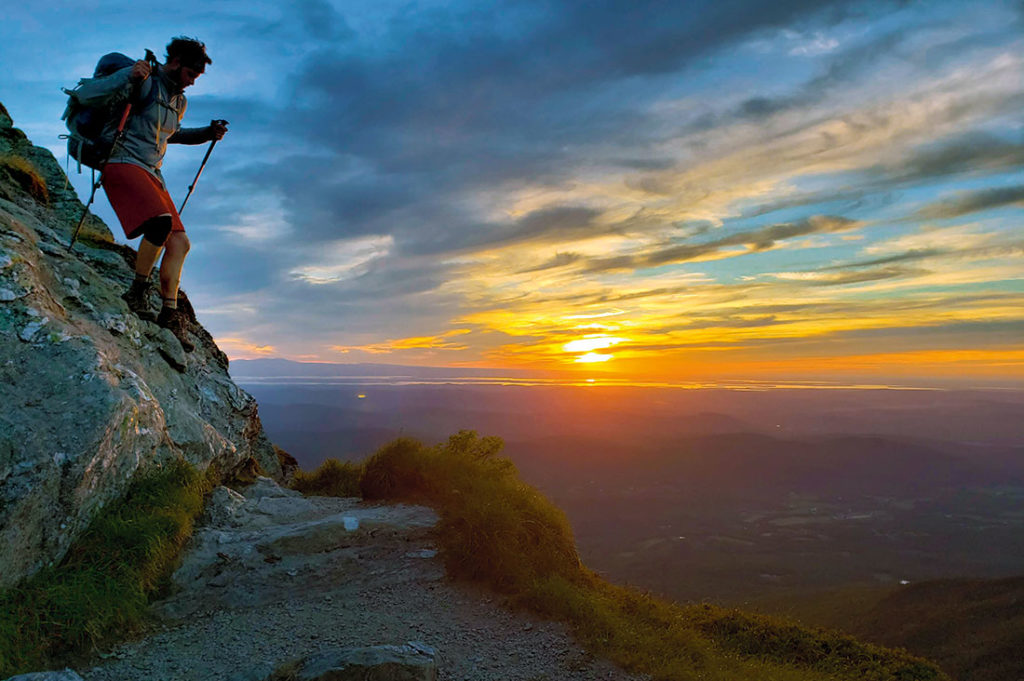
New to the backcountry? Don’t sweat it. These Hiking 101 tutorials and guides provide a beginner-friendly introduction to the backcountry skills you’ll need. Learn about everything from packing a daypack to surviving a winter camping trip. With these preparedness guides and a little practice, you’ll be on your way to feeling comfortable in Vermont’s forests in no time!
Hiking 101 in Vermont
Vermont is beautiful year-round for an outdoor excursion, but “Hiking Season” is generally considered to be between Memorial Day (May) and Indigenous People’s Day (October).
And with GMC’s 500+ miles of trails and recommended hikes, it’s easy to explore close to home, across the state, or explore Vermont as a visitor.
Before you head out, consider seasonal conditions and weather, safety concerns, gear, navigation, and group size, among other things.
Trail conditions. When picking a trail, do your research on the conditions, elevation, and mileage. Be realistic about your ability levels to keep yourself and others safe. It’s always better to turn around early than to risk pushing your limit to reach a summit or other pre-conceived “destination.” A search-and-rescue mission not only requires a lot of resources, but it can be dangerous for first responders. It’s crucial that you avoid dangerous situations and know how to get yourself back out of the forest.
Trail conditions will vary with the seasons, weather, varying levels of daylight, and wildlife activity. You don’t want to cross an open summit in a thunderstorm, slosh through wet trails during Mud Season, or be caught in the dark without a headlamp. Here are some general conditions to consider for a hike during each season; click each image to enlarge:
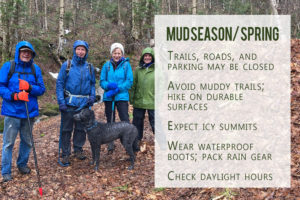
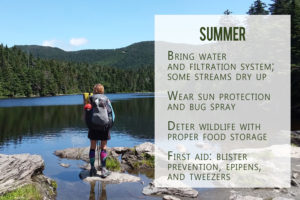
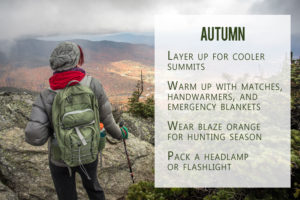
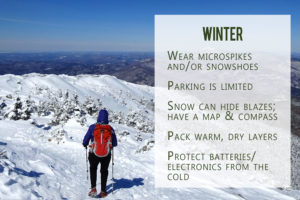
Safety. Before heading out, make sure you leave your plans with someone you trust. It’s equally important to know when to turn back as weather, fatigue, and unexpected conditions affect your hike.
- Familiarize yourself with the HikeSafe Hiker Responsibility Code
- Check trail updates ahead of your trip
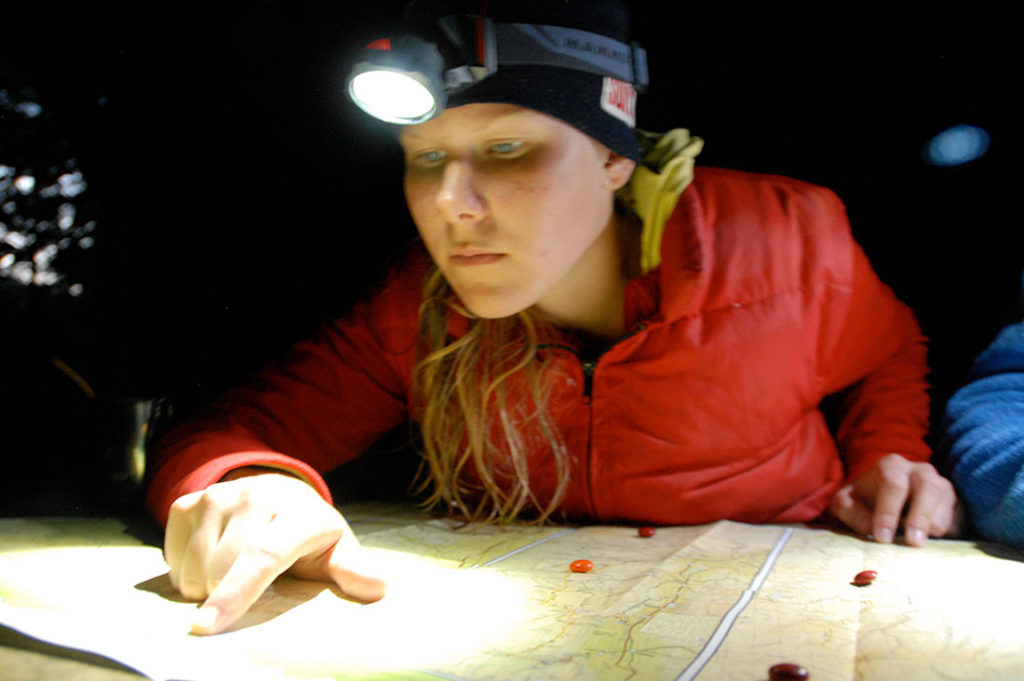
Gear. Planning ahead will help you prevent future emergencies. Your gear should always reflect what sort of trip you’re planning and include emergency supplies. This includes insulation, a headlamp, a first aid kit, and tools. View the 10 Essentials before you head out.
Timing. A hike can span anywhere from a few hours to a few months. Be realistic about the time it requires for you to complete a hike. Generally, plan to hike 1-3 miles per hour; harsh weather, steeper terrain, and possible injuries will slow your pace. Trail guides generally include time estimates but know that every ability level is different, which is okay too. Knowing your skill level will help you plan accordingly for your safety and that of a group.
- Trail Guides: browse guides at the GMC store, TrailFinder, Avenza, Guthook
- Video: Hiking the Long Trail, Side-to-Side
- Video: Hiking the Long Trail, End-to-End
Have fun. Vermont’s Green Mountains, Northeast Kingdom trails, and Appalachian Trail section are great for adventure and exploration. These special places are also great for sharing: bring your family, your dog, and join a group. Just do so responsibly.
Keep scrolling for videos and articles to build your backcountry skillset.
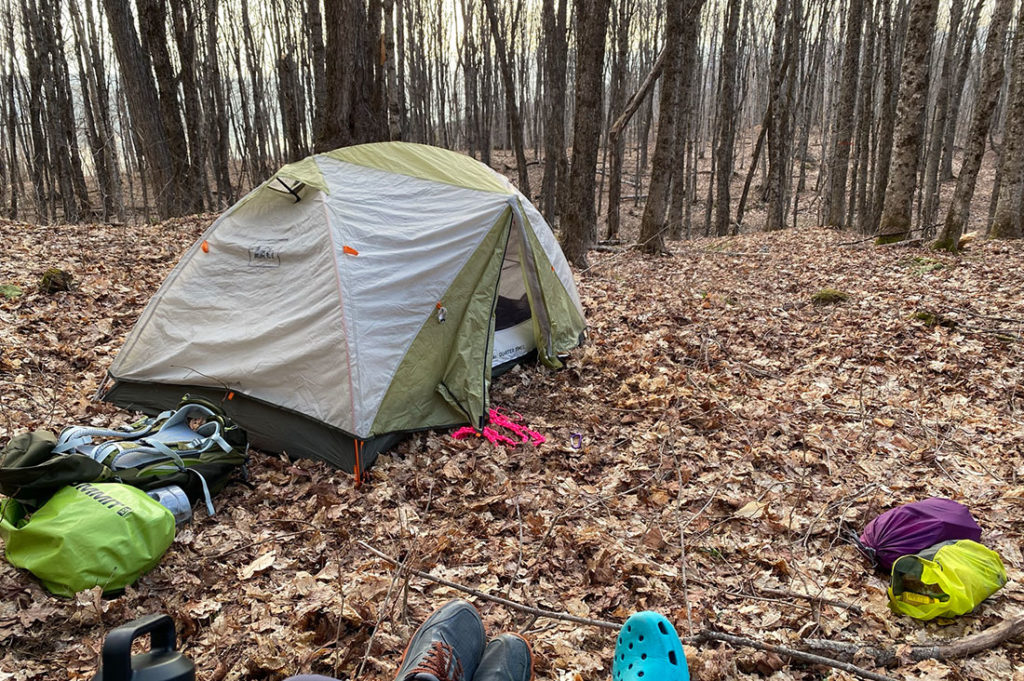
Wilderness Skills
- Video: Leave No Trace
- Video Playlist: Map & Compass
- Video: 10 Essentials of Safe Hiking
- Everything You Need to Know About Bear Safety
- Video: How to Hang a Bear Bag




